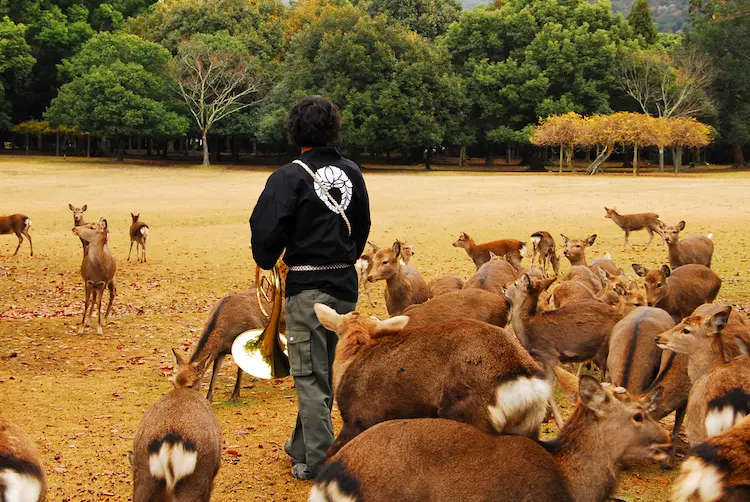Experience the Enchanting Deer Calling Ceremony in Nara – A Winter Tradition You Can’t Miss
Nara Park is home to some of Japan’s most beloved residents: the friendly and curious deer that roam freely. These deer have become synonymous with the charm and beauty of Nara. One of the most enchanting ways to experience this unique connection with nature is through the Deer Calling Ceremony, or Shikayose, held each winter. This tradition offers visitors an extraordinary chance to witness the mystical bond between humans and deer, deeply rooted in Nara’s cultural heritage. If you’re looking for an unforgettable winter event, the Deer Calling Ceremony is a must-see for tourists and locals alike.
1. What is the Deer Calling Ceremony?
The Deer Calling Ceremony, or Shikayose, is a fascinating tradition where a skilled hornblower uses a French horn to summon the deer. The sound of the horn reverberates through the trees, and moments later, the deer come galloping gracefully out of the forest to answer the call. This captivating sight is truly something to behold as dozens of deer rush towards the hornblower, forming a magical moment between nature and humanity.
The origins of this ceremony date back over a century and have since become a cherished aspect of Nara’s culture. The ceremony symbolizes respect for the deer, which are considered sacred messengers of the gods. This deep connection to nature is what makes Shikayose an iconic winter tradition in Nara.
2. When and Where Does It Take Place?
- Location: The Deer Calling Ceremony takes place in Nara Park, specifically near Kasuga Taisha Shrine, one of Nara’s most scenic and culturally significant areas.
- Dates: The ceremony is typically held during the winter months, from December to March, making it a seasonal highlight for those visiting Nara.
- Times: The event usually starts around 10:00 AM, when the deer are most alert and active.
- Access: Nara Park is easily accessible via public transportation. It’s just a short walk from Kintetsu Nara Station, allowing visitors to reach the site conveniently.
3. The History Behind Deer Calling
Deer hold a special place in Nara’s history and culture, regarded as sacred animals connected to the gods. According to Shinto belief, deer are messengers of the gods, particularly associated with Kasuga Taisha Shrine. For centuries, the deer of Nara have been protected as cultural treasures, and this reverence forms the basis for the Deer Calling Ceremony.
The origins of the ceremony can be traced back to the desire to honor and maintain the bond between humans and these revered creatures. The horn used in the ceremony produces a melody that represents harmony and respect, reflecting the deep cultural connection between people and nature. This tradition is not just a performance—it’s a meaningful celebration of Nara’s natural beauty and spiritual heritage.
4. Why You Should Experience It
- Cultural Immersion: Attending the Deer Calling Ceremony offers a unique opportunity to immerse yourself in a piece of Japanese cultural heritage that reflects the harmonious relationship between humans and wildlife. It’s an experience that brings history and tradition to life.
- Family-Friendly: The ceremony is perfect for visitors of all ages. Children and adults alike are captivated by the sight of dozens of deer running towards the hornblower. It’s both educational and incredibly entertaining.
- Photography Opportunities: Imagine capturing the moment when the deer emerge from the forest, their antlers silhouetted against the backdrop of Nara’s beautiful winter landscape. This event provides plenty of opportunities for stunning photographs that are sure to be treasured memories.
- A Unique Experience: Few places in the world offer an event like this—a connection between people and animals in such an authentic and traditional setting. The Deer Calling Ceremony is a reminder of the respect for nature deeply embedded in Japanese culture.
5. Tips for Visitors
- Arrive Early: To get the best view of the ceremony, it’s wise to arrive early. The event is popular, and arriving ahead of time ensures that you secure a prime viewing spot.
- Respect the Deer: While the deer in Nara are generally friendly, remember that they are still wild animals. Avoid sudden movements and loud noises, and respect their space to ensure both your safety and theirs.
- Stay Warm: As the Deer Calling Ceremony takes place in winter, it’s important to dress warmly. Bring a good jacket, gloves, and wear comfortable shoes suitable for walking around Nara Park. The cold weather is part of the charm of this winter event, but staying comfortable will make it more enjoyable.
6. Other Things to Do Nearby
- Visit Kasuga Taisha Shrine: After the Deer Calling Ceremony, take time to explore Kasuga Taisha Shrine, located nearby. The shrine is known for its thousands of bronze and stone lanterns and offers a serene insight into Nara’s spiritual heritage.
- Explore Todai-ji Temple: Home to the Great Buddha (Daibutsu), Todai-ji Temple is one of Japan’s most famous landmarks. A visit here is a great way to continue exploring the deep cultural significance of Nara.
- Nara National Museum: For those who want to delve further into the history and culture of Nara, the Nara National Museum offers fascinating exhibits showcasing Buddhist art and regional artifacts.
- Enjoy Local Cuisine: Wrap up your day by enjoying traditional Nara specialties like kakinoha-zushi (sushi wrapped in persimmon leaves) at a local restaurant. The warm hospitality and authentic flavors will provide the perfect ending to your Nara adventure.
Conclusion
The Deer Calling Ceremony in Nara is more than just a winter spectacle—it’s a moving experience that combines nature, history, and culture in a beautiful and memorable way. Whether you’re drawn by the sight of the deer, the cultural depth of the event, or the chance to experience something truly unique, the Deer Calling Ceremony is an essential part of any winter visit to Nara. Come and be enchanted by the magic of Nara, where tradition meets the natural world in perfect harmony.









